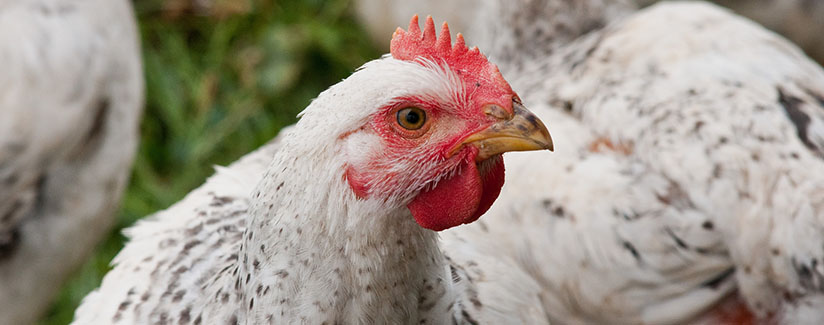
Why are Chemicals Used in Poultry Processing?
09/13/2013
Two articles in the Washington Post have examined the use of chemicals, or processing aids, in poultry processing plants. The first article explains that visibly contaminated chicken carcasses are being treated during regular poultry processing instead of being removed from the line for treatment elsewhere in the plant. This, the article states, allows a plant’s line speed to move faster but plant employees and government inspectors are experiencing health problems from inhaling these processing aids.
The second article discusses the potential lack of effectiveness of those processing aids and how the test results obtained by both the USDA Food Safety and Inspection Service (FSIS) and the industry may be artificially low and are not indicative of what is really on the birds.
We went to Dr. John Marcy, professor and poultry processing specialist at the University of Arkansas, to find out more about this issue.
What about the contention that these chemicals are being used so that plant line speeds can increase?
Dr. Marcy:
The use of these “chemicals,” which are actually antimicrobial interventions or processing aids, has nothing to do with the line speeds. In my time working in or with the poultry industry (since 1975), processing aids have always been a valuable tool for meat processors to clean the birds as they move through the plant as well as keep equipment sanitized so that consumers have the safest food. The use of chlorinated water and other interventions in meat processing actually predates my time in industry. The majority of chemical use, separate from the sanitation function, is part of a multiple-hurdle approach at pathogen reduction as expected by the Salmonella and Campylobacter Performance Standards issued by USDA.
Why are chemicals used in poultry production?
Dr. Marcy:
Put simply, raw food products, including meat and poultry, are not sterile. In an effort to make them and the environment in which they are processed as safe as possible, the industry uses these processing aids to help prevent food borne illnesses.
Both articles discuss concerns around the safety and effectiveness of these chemical interventions. What does a manufacturer have to do to get approval of their product?
Dr. Marcy:
All antimicrobial interventions are evaluated by the federal government for safety and effectiveness. This approval process includes not only interventions that reduce pathogens on poultry products, but also for equipment lubricants, antifoaming agents, and other substances that work to keep facilities clean. The Food and Drug Administration (FDA) evaluates all chemicals approved for use in all food plants. The USDA FSIS evaluates all processing aids used in meat and poultry plants for their purpose and effectiveness, and to establish limits on their use to ensure the meat is fit for consumption. A complete listing of these aids, their use and limits, is contained in a single document here: USDA FSIS Directive 7120.1.
The first Washington Post article discusses the use of peracetic acid as being the cause of health issues experienced by some poultry plant employees and government inspectors. What is it?
Dr. Marcy:
Peracetic acid is a combination of hydrogen peroxide (the same kind you may have in your bathroom closet) and acetic acid. Acetic acid is the acid found in household vinegar. Both the hydrogen peroxide and acetic acid are diluted with water before being used in the plant as an antibacterial treatment. The outcome is that disease-causing bacteria, such as Salmonella, on the surface of the meat and poultry are reduced.
The allowable concentration levels set by FDA and USDA are measured in parts per million. To put one part per million into perspective, it is equivalent to one drop in two full bathtubs of water, or one minute in almost two years.
The second Washington Post article discusses the use of cetylpyridinium chloride (CPC). CPC is an antiseptic that kills bacteria and other microorganisms. It is commonly found in toothpaste, mouthwash and nasal sprays (check the label!).
Are there residues of antimicrobials on the chicken I buy in the supermarket?
Dr. Marcy:
These antimicrobials are diluted significantly when used and break down in water to non-harmful substances. To be considered a processing aid, USDA states that antimicrobials must have no technical effects after they are used, and manufacturers must provide significant data to USDA to demonstrate that is the case. As a result, the use of these processing aids create no food safety concerns; rather, they increase the food safety profile of the product.
Is it safe for workers to come in contact with these chemicals?
Dr. Marcy:
Though these chemicals are approved for use and are used in very low, allowable concentrations, the poultry industry takes very seriously the health and safety of their workforce and all others in a processing facility. There are a number of steps and precautions the industry has in place in order to minimize any exposure to them:
- When diluted antimicrobials are applied to carcasses, they are done so in controlled areas (inside of closed equipment or inside the chiller) to minimize any potential exposure to employees
- In order to ensure proper ventilation, poultry processing plants follow strict guidelines for airflow set by the American Society of Heating, Refrigerating and Air-Conditioning Engineers. Engineering controls, such as ventilation, are acceptable means to control employee exposure to hazards;
- Workers and companies must comply with OSHA standards, wear personal protective equipment and complete required training programs;
- The mixing of water and antimicrobials is a highly automated process. This ensures that workers rarely come into contact with any undiluted agents.
- Concentrations of all antimicrobials used in poultry processing are constantly monitored – not only in the diluted form – but also in the air. The monitoring tools can detect molecules in the air to determine if there is a need to change the process.
The Washington Post article mentions new regulations that are about to take effect. What does this involve?
Dr. Marcy:
USDA published the proposed rule in January 2012 and, from my perspective, there has been a lot of misinformation about what the rule would mean for the industry and for consumers. In a nutshell, traditional inspection involves USDA inspectors evaluating each bird for quality issues such as a broken bone or a bruise (neither of which poses a food safety concern), while also evaluating each bird for food safety parameters. Under the new modernized inspection system, USDA would continue to evaluate each bird for food safety parameters but would also have more time to do food safety evaluations and provide oversight to the entire process, not just at one stop in the plant. Employees would be trained to evaluate the birds for quality issues thereby allowing USDA to focus on their true mission of protecting public health.
Whether chicken plants operate under traditional inspection or choose to opt in to this voluntary, modernized inspection system, rigorous food safety standards are applied to all chicken products and these products must meet or exceed these safety standards set forth by USDA in order to reach consumers.
The second Washington Post article discusses concerns around the effectiveness of interventions at reducing foodborne bacteria. Are these chemicals actually working?
Dr. Marcy:
Yes, they are working. Manufacturers of these products do extensive research and must document their safety and effectiveness before any product is approved for use by FDA and USDA. Both federal agencies must review all effectiveness and safety data prior to approving the product. Additionally, evaluation of these interventions is frequently repeated by others in the industry. With the help of effective processing aids and new technologies, the chicken industry has successfully reduced the prevalence of both Salmonella and Campylobacter in all raw chicken products.
The second Washington Post article discusses the need for a neutralizing agent. What is that?
A neutralizing agent is a buffered solution that makes the solution neutral in pH – not acidic or basic. The thought is that a neutral solution would prevent further activity of the intervention on the bacteria, if present, in the rinsate (the solution left after rinsing).
“20130712-AMS-LSC-0628.jph” by USDA is licensed under CC BY.


























